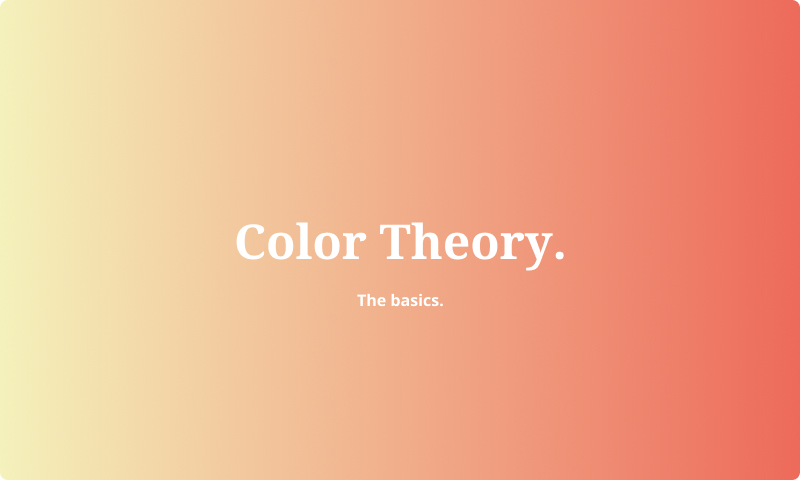
In this article, you'll read about the basics of color theory. We'll talk about what color theory is, why it is important, how it can affect and influence people, a thing or two on contrast, and much more.
What is color theory?
Color theory is the field of study that studies the meaning, symbolism, application, types, and psychology of color.
It is the study of how color affects the way we perceive and react to things and the ways that color influences our lives and the world around us. One great example of color theory is all the reasons behind why blue is such a popular color around the world.
It has been a subject of great interest and fascination for people from all walks of life, from artists and designers to scientists and philosophers.
Even today, color theory is an integral part of our everyday lives. Color tells a story. It causes certain feelings and emotions and influences our decision-making.
Designers don't choose colors only because a certain color looks good. Instead, they choose colors because good use of color tremendously influences the user's experience.
History of color theory
Color theory is much older than modern design, computers, and design software. It was invented in 1666 by English physicist Isaac Newton.
During that same year, he created the color wheel, which we still use today.
Newton was fascinated by the colors of the rainbow, and he understood that they were made of different wavelengths of light.
He also understood that color is not some constant but rather a human perception of a range of wavelengths.
That's when he came up with the idea of the color wheel. He divided colors into three categories:
Primary colors. These are colors that can't be created from any other color: red, blue, and green.
Secondary colors. You make these colors by mixing the primary colors.
And finally, tertiary colors. Mix secondary colors to create tertiary colors.
Since then, color theory has constantly been evolving. Today, we have two different directions or two different ways of looking at color.
The first way is color for print and follows the CMYK color model. CMYK is a color model used in printing, photography, art, and other types of printing.
CMYK consists of three colors: cyan, magenta, and yellow. The K stands for 'key,' or black.
The second way to look at color is the color you see on screens. This way of looking at colors follows the RGB color model. This is the most popular one as it is a part of the devices we use daily.
On top of these, today, we also have the HSL color model, which is based on color properties. Since Newton, we found out that every color has three main properties:
Hue. Every color has a hue at its core. It represents its appearance, like red, yellow, or purple.
Saturation. A higher saturation value means a more vibrant color.
Lighting. In other words, how pale that color is or how bright that color is.
To make full use of color theory, you have to know the properties of the colors you use. You have to understand how they affect users, how they affect each other, and how they affect the design as a whole.
Why is color theory important?
In their research "Why Color Matters", Colorcom found out that within 90 seconds, users will make a subconscious decision about your product that is 62%-90% based on color.
This means that you must make sure you use the right colors to attract users and express your message to them.
How many colors are there?
It's a challenging question to answer how many colors there are. It depends on the perspective you take. You could, for example, look at it from a color spectrum's perspective, which would mean that there are seven colors.
From a digital color depth's perspective, there are over 10 billion colors, however. Are there 7 colors or over 10 billion. It depends!
Is white the absence of color?
One question that's been hanging around the color theory community is if white is a color or rather the absence of color. It's a tough question with many perspectives.
One of the views is that white is indeed the absence of color, because when we see a white object, it means that all color wavelengths have been reflected by the object's surface.
Then there's also grey. You can make grey by mixing black and white. The result is a color. That speaks to the opinion of white being a color, too.
What color do we see first?
Understanding how our eyes see color and which colors we see first is important. Why? Well, it can help you design your store or online branding in a way that stands out. It's good for business if you do it well.
Based on factors like contrast and saturation, it is likely that our eyes see yellow or a very bright green first. Use that to your advantage!
Color theory in popular culture
Color theory is all around us, from the color of lightsabers to your next blockbuster movie. It's there! Did you know that every lightsaber color has been carefully chosen to be a part of a big color theory?
Color in nature
Color plays a deep role in nature. Just look at how certain animals blend in with nature to survive and be invisible for predators or how flowers use bright colors to attract insects.
One other interesting question about color theory in nature is whether or not the color of water affects its evaporation. The short answer is that it only plays a slight indirect role compared to bigger influences like temperature and humidity.
